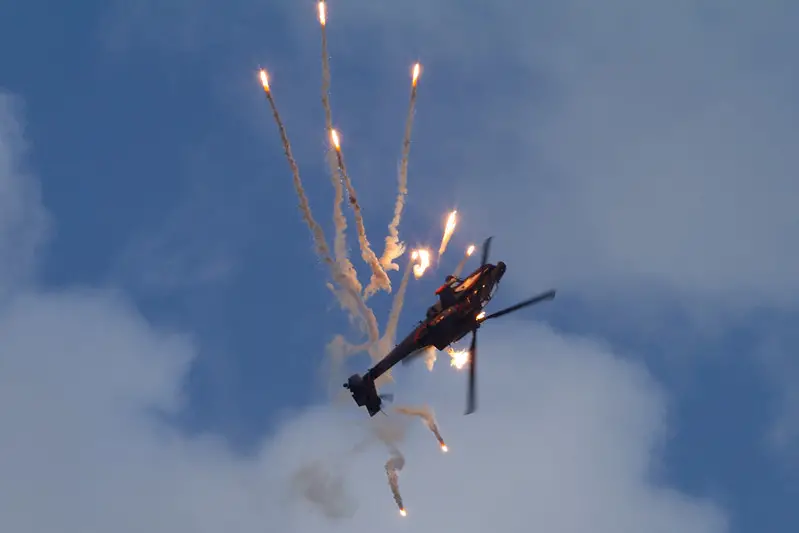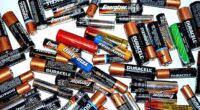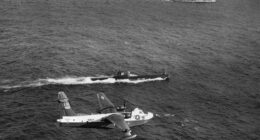Chaff and flares are both used as countermeasures against missiles. Chaff is a material that is released in order to confuse the radar of a missile. Flares are bright objects that are set off in order to dazzle the infrared seeking guidance system of a missile.
What is chaff?
(Photo By Commander, U.S. Naval Forces on Flickr)

Chaff is a countermeasure used to confuse radar-guided missiles. It consists of small strips of metal, usually aluminum, that are cut to a specific length to reflect the radar signals emitted by the missile’s guidance system. When released from an aircraft, the chaff creates a cloud of small reflective particles that confuse the missile’s radar, making it difficult for the missile to lock on to the actual target. Chaff is often used in combination with other countermeasures, such as flares, to provide more comprehensive defense against missile threats.
What are flares?
(Photo by Bernard Spragg. NZ on flickr)

Flares are a type of countermeasure used to defend against heat-seeking missiles. They consist of small canisters filled with a mixture of chemicals that burn at a high temperature, creating a bright and hot infrared signature. When released from an aircraft, the flares divert the missile’s infrared seeker away from the aircraft and towards the heat source of the flare, which is usually the exhaust of the aircraft’s engines. This diversion of the missile’s seeker reduces the probability of a successful missile lock-on and increases the aircraft’s chances of evading the missile. Flares are often used in combination with other countermeasures, such as chaff, to provide more comprehensive defense against missile threats.
Chaff Vs. Flares – Key differences
Chaff and flares are two types of countermeasures used to protect military aircraft from being hit by enemy missiles. Here are the key differences between chaff and flares:
Function: Chaff is a cloud of small, thin metal strips that are released to create a radar signature that confuses the missile’s guidance system. Flares, on the other hand, are small, bright heat sources that are released to decoy the missile’s infrared seeker.
Composition: Chaff is made up of small strips of aluminum or other metals, while flares are typically made of a combination of metal powder and an oxidizer.
Deployment: Chaff is typically deployed in large quantities from a dispenser attached to the aircraft, while flares are typically deployed in smaller quantities from launchers on the aircraft.
Effectiveness: Chaff is effective against radar-guided missiles, while flares are effective against infrared-guided missiles.
Visibility: Chaff is not visible to the naked eye, while flares produce a bright, visible light.
Cost: Chaff is relatively inexpensive to produce and deploy, while flares are more expensive.
Both chaff and flares are important countermeasures used to protect military aircraft from being hit by enemy missiles, but they serve different functions and are effective against different types of missiles.
Why do fighter jets release chaff?
Fighter jets release chaff to protect themselves from radar-guided missiles. Chaff is made up of small, thin metal strips that are released in large quantities to create a cloud of reflective material that confuses the missile’s guidance system. When the missile’s radar system detects the chaff, it receives multiple reflections and becomes confused, causing it to lose track of the aircraft it was targeting. This gives the aircraft a chance to maneuver to a safer position or launch its own countermeasures. Chaff is a relatively simple and effective way to protect aircraft from radar-guided missiles, and it has been used by military aircraft for many years.
How hot is chaff and flare?
Chaff and flares are two different countermeasures used by military aircraft to avoid being hit by heat-seeking missiles.
Chaff is made up of small, thin metal strips that are released in large quantities to create a cloud of reflective material that confuses the missile’s guidance system. Chaff does not produce any heat, and its temperature is not relevant to its function.
Flares, on the other hand, are small, bright heat sources that are released to decoy the missile’s infrared seeker. Flares typically burn at a temperature of around 2,200 degrees Celsius (4,000 degrees Fahrenheit) and produce a bright, visible light. This heat and light signature is intended to decoy the heat-seeking missile away from the aircraft and towards the flare.
It’s important to note that chaff and flares serve different functions and are used to counter different types of missile threats. Chaff is effective against radar-guided missiles, while flares are effective against heat-seeking missiles. Both chaff and flares are important countermeasures used to protect military aircraft from missile attacks.
Why do flares stop missiles?
Flares are used as a countermeasure to stop missiles that are seeking heat signatures. When an aircraft is targeted by a missile, the missile uses its infrared seeker to detect the heat signature of the aircraft’s engines or exhaust. The missile then homes in on this heat signature to hit the aircraft.
To counter this, the aircraft can release flares, which are small, bright objects that burn at a very high temperature, typically around 2,200 degrees Celsius (4,000 degrees Fahrenheit). The flare produces a heat signature that is hotter than the aircraft’s engines or exhaust, which attracts the missile’s infrared seeker towards it instead of the aircraft.
When the missile is attracted to the flare, it follows the flare’s heat signature instead of the aircraft, causing it to miss its intended target. This diversion created by the flare allows the aircraft to evade the missile and escape the threat.
Flares stop missiles by creating a more attractive heat signature than the aircraft’s engines or exhaust, which causes the missile to follow the flare instead of the aircraft. This diversion allows the aircraft to escape the missile’s path and evade the threat.
Which is better chaff or flares?
Chaff and flares serve different purposes and are effective against different types of missiles. Chaff is used to counter radar-guided missiles by creating a cloud of metal strips that reflects radar signals and confuses the missile’s guidance system. Flares, on the other hand, are used to counter heat-seeking missiles by diverting the missile’s infrared seeker away from the aircraft and towards the heat source of the flare.
Which one is better depends on the specific situation and the type of missile threat. In some cases, a combination of chaff and flares may be used to provide more comprehensive defense against different types of missile threats. Both chaff and flares are important countermeasures used to protect military aircraft from missile attacks.
The advantages and disadvantages of chaffs and flares
Advantages of Chaffs:
- Effective against radar-guided missiles: Chaff is highly effective against radar-guided missiles, as the metal strips reflect radar signals and create a cloud of false targets, making it difficult for the missile to lock on to the actual target.
- Low cost: Chaffs are relatively inexpensive to produce and deploy, making them a cost-effective countermeasure against missile threats.
Disadvantages of Chaffs:
- Limited effectiveness against heat-seeking missiles: Chaff is not effective against heat-seeking missiles, which are guided by the heat signature of the target.
- Limited range: Chaff has a limited range and is effective only when deployed close to the aircraft, which may limit the aircraft’s ability to maneuver.
Advantages of Flares:
- Effective against heat-seeking missiles: Flares are highly effective against heat-seeking missiles, as they divert the missile’s infrared seeker away from the aircraft and towards the heat source of the flare.
- Longer range: Flares have a longer effective range than chaff and can be deployed at a greater distance from the aircraft, which provides more flexibility in maneuvering.
Disadvantages of Flares:
- Higher cost: Flares are more expensive than chaff and may not be as cost-effective against certain missile threats.
- Limited effectiveness against radar-guided missiles: Flares are not effective against radar-guided missiles, which may limit their overall effectiveness in certain situations.
Both chaffs and flares have their advantages and disadvantages and are effective against different types of missile threats. A combination of chaffs and flares may be used in certain situations to provide more comprehensive defense against different types of missile threats.
Featured Image By – Martin de Witte on flickr








